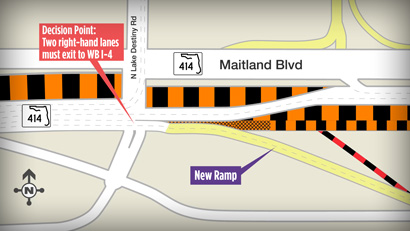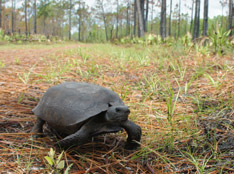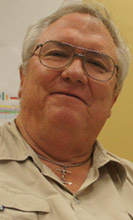|
|
|
|
Major Traffic Shift on Maitland Boulevard Scheduled for July
|
 |
Motorists who use eastbound Maitland Boulevard (State Road 414) can expect a significant traffic shift of about 1.25 miles from State Road 434 to westbound Interstate 4 (I-4) this month.
The eastbound lanes of Maitland Boulevard will be shifting to newly paved lanes, just south of the existing lanes. In addition to the traffic shift, a new westbound I-4 on-ramp from eastbound Maitland Boulevard will open at the same time. The new ramp will require motorists to choose if they want to continue on eastbound Maitland Boulevard or enter the westbound I-4 entrance ramp before the intersection of Lake Destiny Road.
At the intersection of Lake Destiny Road, there will be six lanes on eastbound Maitland Boulevard: two left-hand lanes will turn left onto Lake Destiny Road; the middle two lanes will continue eastbound on Maitland Boulevard; and the two right-hand lanes will enter the westbound I-4 entrance ramp (the far right-hand lane will have an option of turning right onto Lake Destiny Road). After passing the traffic light at the Lake Destiny Road intersection, motorists will be unable to switch between the eastbound Maitland Boulevard through lanes and the lanes leading to the westbound I-4 entrance ramp because the new ramp is elevated.
The upcoming traffic shift on eastbound Maitland Boulevard will play a pivotal role for construction progress on the corridor. A future traffic shift for the area will move the westbound Maitland Boulevard lanes to the old eastbound lanes, opening the old westbound lanes for complete reconstruction. The future Maitland Boulevard will be elevated over surface streets west of the I-4 interchange through Maitland Summit Boulevard creating signal-free traffic.
For more information about the new I-4 and Maitland Boulevard interchange and Maitland Boulevard overpasses visit i4ultimate.com/futureMaitland. Sign up to receive I-4 Ultimate construction alerts by email or text at i4ultimate.com.
|
|
|
New Temporary Ramps Opening on I-4
|
-410x273.jpg) |
New temporary ramps are opening throughout the I-4 Ultimate project, as construction progresses to open new work zones along the 21-mile project corridor.
Many of these new ramps, while temporary, are in the footprint of the future Interstate 4 (I-4) ramps. Motorists will notice these new ramps feature longer lanes. Longer ramps help to accommodate more vehicles, reduce backups on I-4 and improve overall safety of an interchange.
As new temporary ramps open along the corridor, motorists should be aware of the changing traffic patterns. In many cases, the temporary ramps require motorists to exit sooner than the old I-4 ramps.
NEW TEMPORARY RAMPS
- Eastbound I-4 exit to Fairbanks Avenue — Opened in June, the longer ramp requires motorists to exit I-4 several hundred feet sooner.
- Eastbound I-4 exit to Princeton Street — Opened on July 6, the longer ramp requires motorists to exit I-4 several hundred feet sooner. When completed, the ramp will add one additional right-turn lane.
- Westbound I-4 entrance ramp from eastbound Maitland Boulevard (State Road 414) — Opening in mid-July, this on-ramp will require eastbound Maitland Boulevard motorists to be in the two right-hand lanes before the Lake Destiny Drive intersection.
- Eastbound I-4 exit to Lee Road (State Road 423) — Opening in mid July, the temporary ramp will create a new work area. When completed, one additional lane will be added to the exit ramp.
- Westbound I-4 exit to northbound Kirkman Road (State Road 435) — Opening in late July, the longer ramp will require motorists to exit I-4 about a quarter mile sooner.
- Westbound I-4 exit to southbound Orange Blossom Trail (US 17-92/441) — Opening in mid-July, this ramp is strictly temporary but will require motorists to exit I-4 about a quarter mile sooner. Similar to the old ramp, it will require motorists to exit on the left-hand side of I-4. However, the temporary ramp will form a temporary intersection at Orange Blossom Trail, between the westbound and eastbound lanes of I-4. The future I-4 exit ramp at this interchange will be on right-hand side of I-4.
To be notified when new temporary ramps open, sign up for I-4 Ultimate construction alerts at http://i4ultimate.com/construction-info/alerts/.
|
|
|
Preparations on I-4 Ultimate for Hurricane Season
|
 |
Just like a homeowner preparing for a big storm, the I-4 Ultimate team must make preparations when a hurricane or tropical storm threatens to make landfall and impact Central Florida.
The I-4 Ultimate team has 21-miles of roadway to look after and a set of state-approved policies to follow. Those guidelines are designed to minimize damage while keeping employees safe, essential staff on duty and emergency routes open.
Joseph Morffi, Operations & Maintenance Manager for SGL Constructors and the I-4 Ultimate team, oversees the storm preparation. He has helped to create many such plans during his career.
Significant response begins as early as when the storm starts to produce sustained winds of 40 mph and is within five days of coming ashore. First preparations include stocking up on supplies and making sure that equipment such as trucks, excavators, bulldozers and portable pumps and generators are fueled and in good repair.
The team also reviews plans for carpooling essential employees. These are the people who help with storm mitigation and are available to work during the storm. The idea is to minimize the number of I-4 Ultimate team members who have to drive in bad weather. The plan assigns a few drivers with four-wheel-drive vehicles to do pick up and drop off.
Preparations include securing or removing items such as barrels, barricades, temporary signage or anything else on the job site that strong winds could carry off. Rings of lights on high-mast poles may be lowered to prevent damage during the storm.
The team also has to consider the extra demands made on the drainage system during a storm. Drains are checked for blockages and anything nearby that easily could be swept into the openings, resulting in backups.
There may be fairly large areas of exposed ground or high mounds of dirt on the construction sites. Areas deemed likely to erode in a powerful storm may be covered with a filter fabric to help hold the dirt in place.
|
|
|
Relocated Gopher Tortoises Find New Home
|
 |
| |
Some 29 gopher tortoises living along Interstate 4 (I-4), have some new digs to call home.
SGL Constructors, the design-build joint venture for the I-4 Ultimate Project, along with the Florida Fish and Wildlife Conservation Commission (FWC) and Florida Forever collaborated to relocate the gopher tortoises to Florida Forever’s nearly 4,000-acre conservatory in St. Cloud.
Gopher tortoises are classified as a threatened species.
The relocation allowed for the tortoises to thrive in a safer environment and for SGL Constructors and other contractors to continue construction.
The tortoises were moved from 101 surveyed burrows, according to Matt Baumann, Environmental Compliance Manager with SGL Constructors. Gopher tortoises often live in several different burrows moving from one to the other.
“We had a pre-construction survey of the burrows,” he said. “Then, an ecological expert verified the active burrows, and we received a permit from FWC to relocate.”
The majority of the tortoises lived within the northernmost limits of the project, such as Maitland or Longwood, Baumann noted.
“We found them by the westbound side of I-4 just south of E.E. Williamson Road,” he said. “The majority are on the north end of the project.”
It costs about $1,800 per tortoise for the relocation including permit fees, recipient site fees and wildlife consultant fees.
But the lives of 29 threatened gopher tortoises are worth it, said Dr. William Broussard, founder and president of Florida Forever and the Alan Broussard Conservatory.
Broussard, a retired ophthalmologist, designated the land southeast of Orlando in 1990 in memory of his son, Allen, who was a wildlife biologist and ecologist.
“About a quarter of our 4,000-acre property is prime gopher tortoise habitat,” Broussard explained. “We’ve taken in about 1,200 tortoises from all over the state in the past six or so years.”
The tortoises graze on low-growing grasses and plant life, which is why they may be attracted to the banks of the I-4 Ultimate project, he noted.
“Their prime habitat is the pine flatwoods,” Broussard said. “We maintain it with controlled burns, too. That’s critical. It allows plant life to replenish. The tortoises then eat the fresh low-growing grass.”
The tortoises can look forward to many years in their natural habitat, as they can live about 50 to 60 years in the wild, he said.
The relocation along I-4 is complete, and barriers were erected to exclude any tortoises trying to return to the construction zone.
Baumann and the I-4 Ultimate team also are on the lookout for eastern indigo snakes, another protected species. So far, they’ve found none.
“But if we do, we’re going to follow the same process with the FWC to make sure they’re OK,” Baumann said.
|
|
|
Road Rangers: Always Ready to Roll
|
 |
Traffic incidents are bound to occur. But what happens in the moments right after a motorist has a flat tire or engine trouble on Interstate 4 (I-4) can mean the difference between a minor inconvenience and a major traffic shutdown.
That’s where the I-4 Ultimate Road Rangers – a fleet of roadside-assistance trucks and their drivers – enter the scene as the interstate’s problem solvers and troubleshooters. They can render a number of services for free, including changing a flat tire, providing gas, making minor mechanical repairs, and towing a disabled vehicle to a safe spot. Moreover, they are just a phone call away at *347 (*FHP).
“We want to make sure that people, products and goods get through the corridor in a safe, efficient manner,” said Joseph Morffi, Operations & Maintenance Manager for SGL Constructors and the I-4 Ultimate team. Although his group can do a lot, Morffi urges drives to stay alert to ongoing changes on I-4 to avoid accidents in the first place.
The I-4 Ultimate Road Rangers are ready to roll 24 hours a day along the 21-mile reconstruction project that stretches from west of Kirkman Road in Orange County, to east of State Road 434 in Seminole County. During peak hours, the group may have as many as 10 trucks on the road, dealing with disabled or abandoned vehicles, traffic accidents or debris in the roadway.
Since the project began about a year ago, the I-4 Ultimate Road Rangers have responded to approximately 20,500 incidents, and the team has met its goal of reaching trouble spots within 30 minutes in 99.8 percent of all cases. Indeed, they reached drivers in need within 10 minutes almost 70 percent of the time.
Moreover, motorists who have been helped appreciate the quick response, as a high percentage have sent in comments similar to Barbara from east Orange County, who wrote, “Very fast and helpful service. Excellent job. Thank you!”
|
|
|
Employee Spotlight: Carl Callahan
CARL CALLAHAN
Quality Assurance Supervisor, Project Areas 1 & 2
Resident of Haines City and Hollywood, Florida
After 41 years as a civil engineer, Carl Callahan has watched his field change from slide rules and hand-drawn plans, to hand-held computer tablets containing all the electronic tools an engineer needs.
But he has noticed that one aspect remains unchanged. Throughout the decades, engineers have required more than impeccable technical skills to succeed. They need people skills as well.
“It’s people that build these projects not machines,” said Callahan, who is a quality assurance supervisor for Volkert – part of the I-4 Ultimate team.
“To advance in this field usually means taking on managerial tasks,” he said. “That means learning how to deal with people – not just by texting – but by talking face to face. Communication is not simply an information transfer. It’s also team building and mentoring.”
Although he loves the sciences, Callahan’s background might have prepared him to see life as less predictable than the math formulas upon which engineers rely. Born in Topeka, Kansas, he never knew his dad, who was serving in the Korean War and died in in a North Korean prison camp before he was born. Yet Callahan grew to find his own path to adulthood through a civil engineering degree from the University of Kansas.
His varied career has taken him from Missouri to the the bitter cold of Minnesota, where he reviewed Minnesota Department of Transportation’s bridge inspection program for the governor, and then down to the muggy swamps of New Orleans, where he spent many evenings working on barges in the bayou. He was the nightshift quality control manager on a project to build storm-surge walls in the aftermath of Hurricane Katrina.
Today, as a member of the I-4 Ultimate team, Callahan and his team check on the quality and safety of bridges in Areas 1 and 2 (from west of Kirkman Road to just past Colonial Drive). In total, more than 140 bridges will be widened, added or replaced along the 21-mile reconstruction project.
The Sunshine State is a good stop for Callahan and his family, who live in Hollywood, Florida. However, while working on the I-4 Ultimate project, he lives in a trailer in Haines City, traveling back forth when he can.
At this stage in his career, Callahan enjoys being a mentor. “I want to pass on what I know. I think that’s part of your obligations – to help make the transportation system and society better. This is an exciting time. The field is in good hands with the young people entering the profession.”
Callahan also has a message: Don’t neglect the other side of your brain – the creative arts and the art of managing a diverse workforce. It’s not all about the numbers. “You also have to know how to relate and communicate.”
|
|
|
|
|
|


-th.jpg)







-410x273.jpg)




